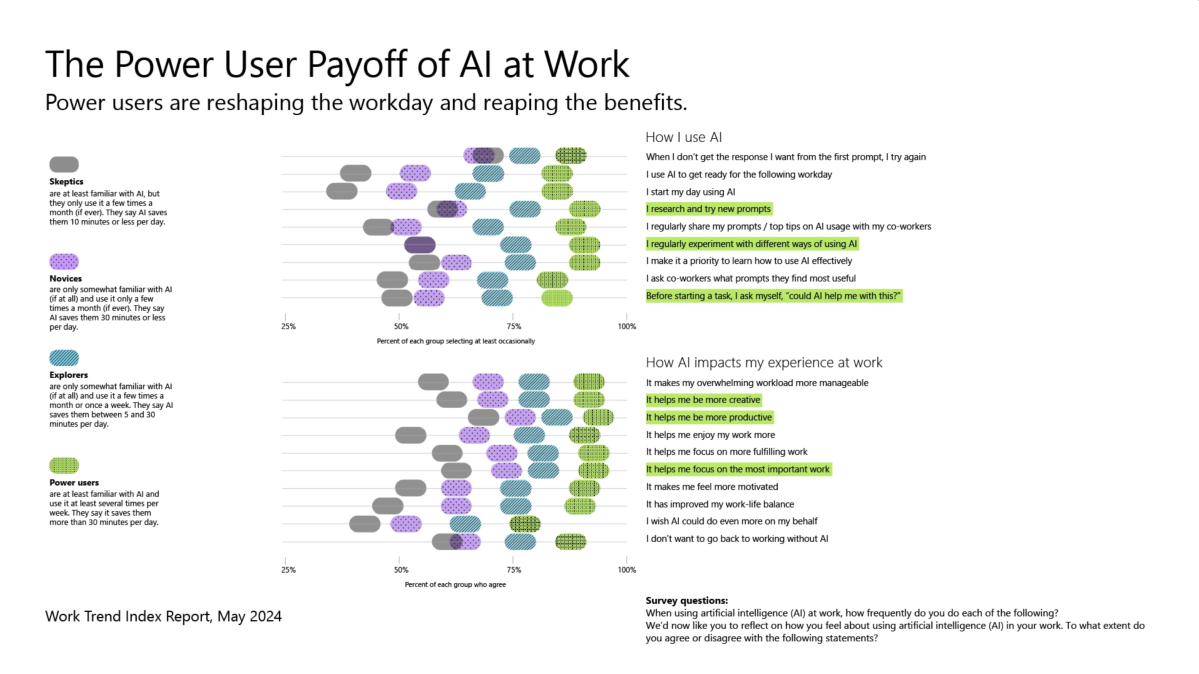Microsoft’s latest trends index shows, unsurprisingly, that workers are capitalizing on the AI craze. But Microsoft’s report also says that they’re doing so reluctantly, and not saving an enormous amount of time in the process.
Microsoft released its 2024 Work Trends Index on Tuesday, reporting what workers outside the company are telling them about how they work. Obviously, the key topic was AI, the foundation of Microsoft Copilot and Copilot-powered applications like Microsoft 365. Microsoft said that its data was acquired by surveys with 31,000 people across 31 countries, alongside “labor and hiring trends” from LinkedIn and “Microsoft 365 productivity signals.”
But the data wasn’t all positive. While employers are seeking employees with AI skills, those workers aren’t being offered training to use them. Instead, they’re learning those skills on their own.
Here are the most (un)surprising bits of data from Microsoft’s 2024 Work Index.
Workers aren’t dumb…
AI, obviously, is hot. Sixty-six percent of leaders say that they won’t hire someone without AI skills, Microsoft found. So Microsoft said that it also found that the number of workers who added AI skills like ChatGPT and Copilot to their list of LinkedIn skills increased at a whopping 142 times compared to the previous survey, with “content writers” (gulp), designers, and marketers using AI the most.
Microsoft
…but they are nervous
Abot half (52 percent) of those who use AI are reluctant to admit that they’ve used it for important tasks. And slightly more (53 percent) say that if they do use it on work tasks it makes them look replaceable.
Only (?) 45 percent of workers say that they’re worried that AI is going to take their jobs, however.
…And overworked
About 78 percent of users are bringing their own AI tools to work, a trend Microsoft calls BYOAI. But less than half of those employers are providing AI tools for their employees, and just 39 percent of those surveyed say that they’ve received training for those tools, too.
About 46 percent of those surveyed said that they felt “burnt out” by work, with 68 percent saying that they “struggle” with the pace and volume of work. The vast majority (85 percent) of email is read in less than 15 seconds, and users read four emails for every one that they send.
So is AI the answer? Sort of
About 75 percent of “knowledge workers” use AI at work, Microsoft says.
AI can be used for all sorts of things: to supply ideas, write emails, help with coding, and more. More and more, AI developers are pitching it as a way to avoid the drudgery of work. But are people actually using AI, and for what? It sounds like the answer to that is a resounding “maybe.”

Microsoft
Microsoft broke out its survey responses into groups ranging from AI “skeptics” to “power users.” Skeptics barely touch AI, and it saves them just a few minutes per day. But power users say that it saves them about 30 minutes per day, specifically to catch up on missed meetings (56 percent), to design visual content (49 percent), to interact with customers (49 percent), and to brainstorm or problem-solve (37 percent). But 46 percent of those who had used AI at work had done so for less than six months.
Microsoft even commissioned a study looking at how 3,000 people used Copilot at work, and whether it made a difference. The results were somewhat inconclusive: Employees read 11 percent fewer emails, but spent the same time (or even more) in meetings. Copilot users even spent 10 percent more time editing documents in Microsoft Office, which Microsoft took as an indication that people were spending more minutes in analysis and content creation.
So is AI making a difference? It’s not clear. “As AI becomes ubiquitous in the workplace, employees and businesses alike are under extreme pressure,” said Jared Spataro, the former Microsoft Office chief who is now corporate vice president of AI at Work. “The pace and intensity of work, which accelerated during the pandemic, has not eased, so employees are bringing their own AI to work.”
That sounds like employees are seeking any lifeline to ease their burden, and AI just happens to be the most convenient.



